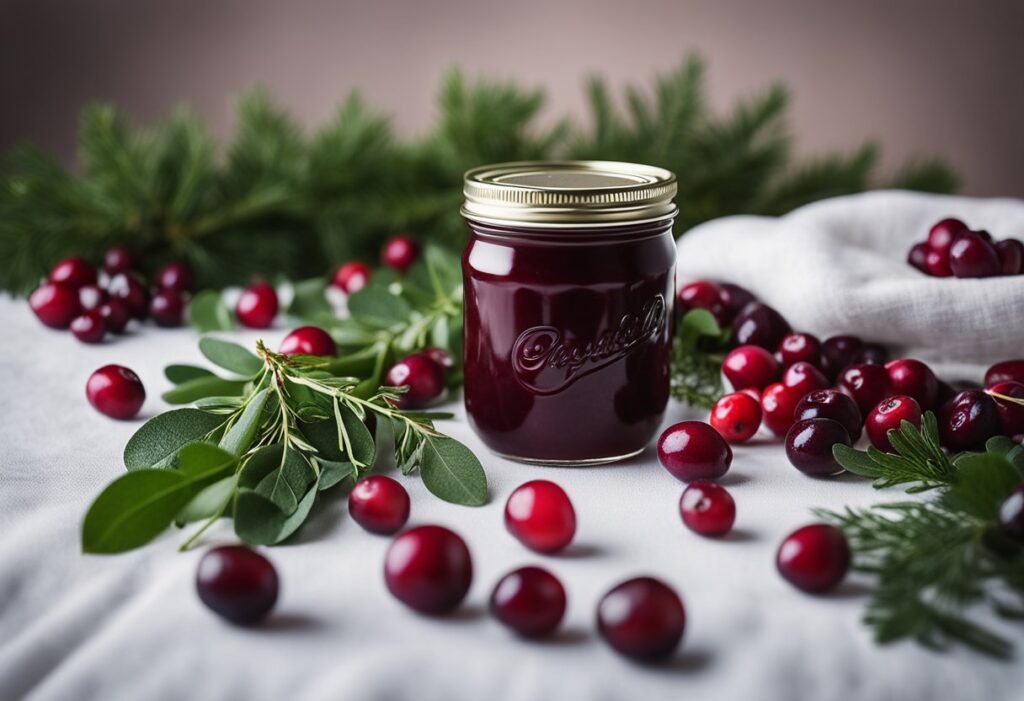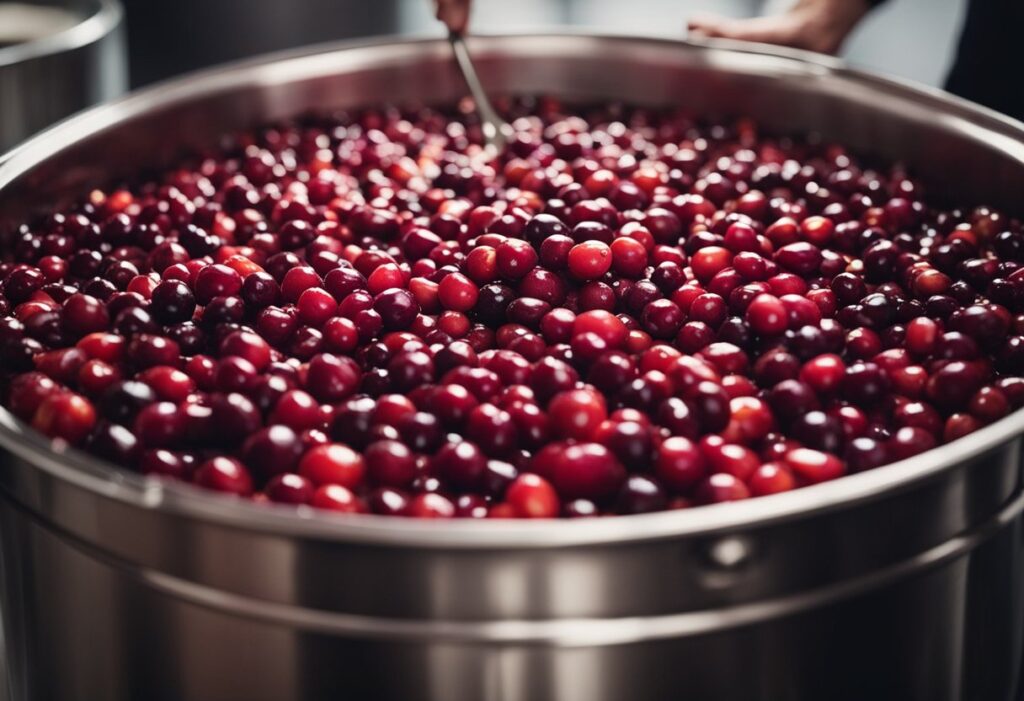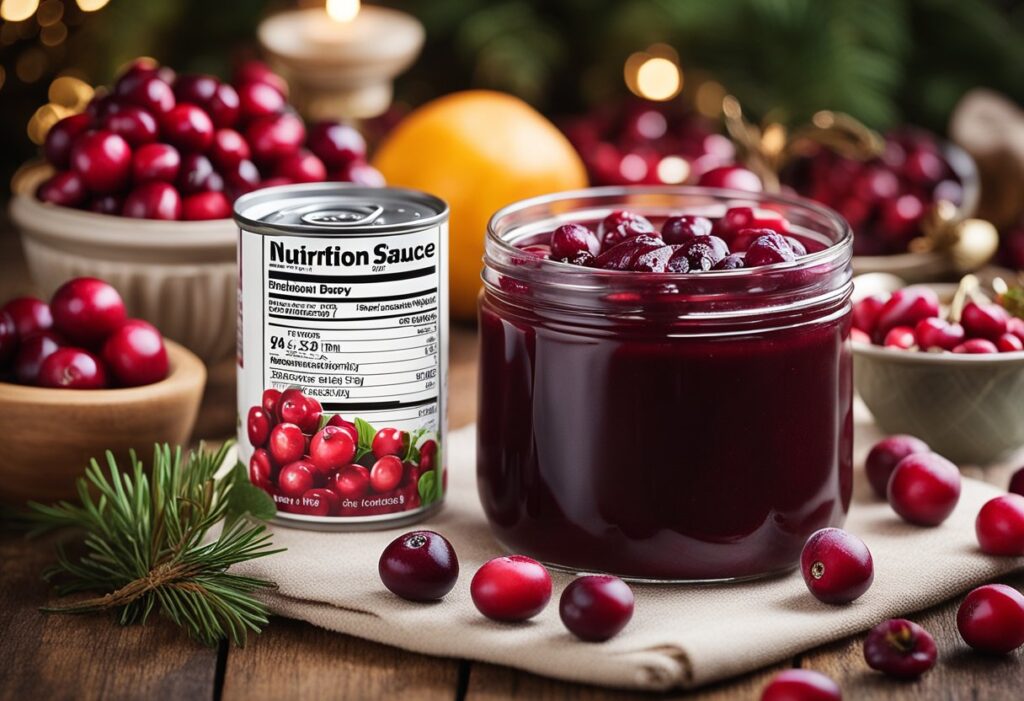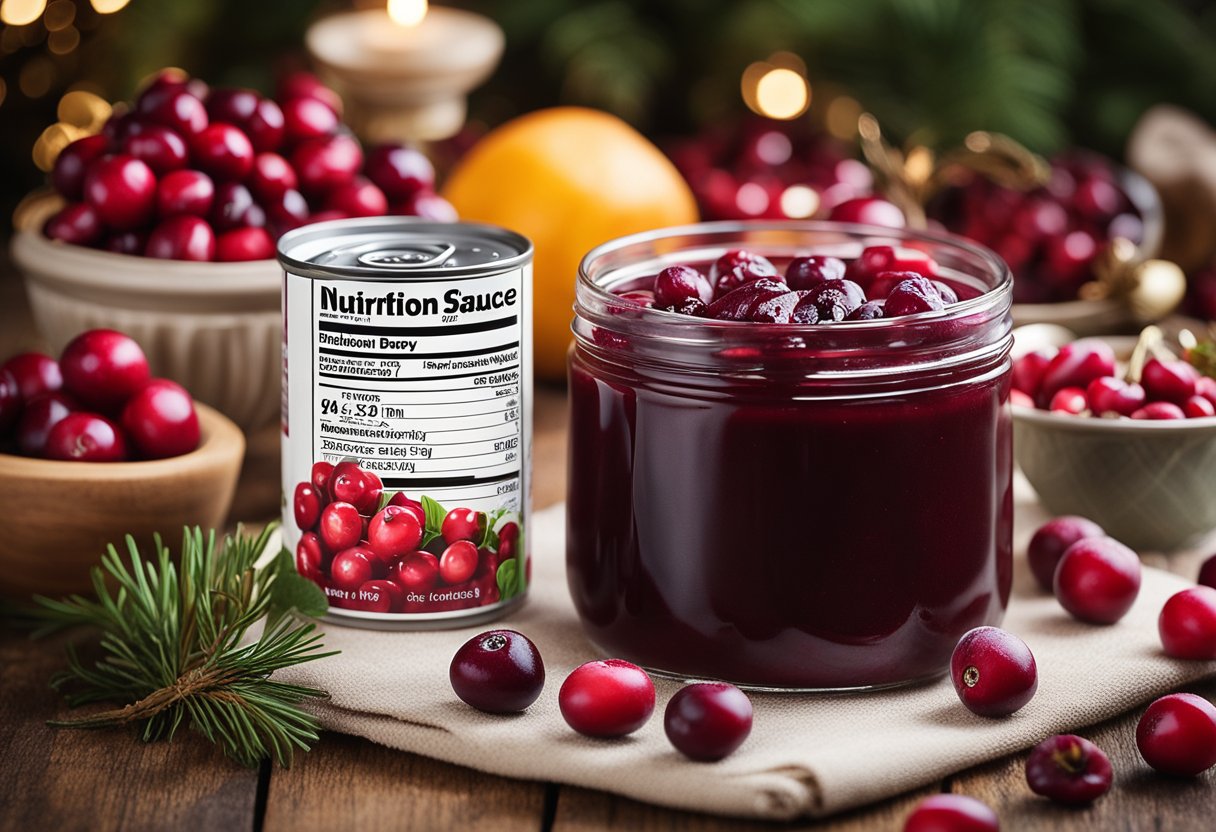Canned cranberry sauce is a popular item on many Thanksgiving and Christmas dinner tables. It is a convenient and easy-to-serve side dish that can be purchased at any grocery store. The sauce is made from cranberries that have been cooked and sweetened, and then canned for preservation.
Table of Contents

Cranberry sauce has a long history in American cuisine, dating back to the early 18th century when Native Americans taught settlers how to use the fruit. The sauce became a staple at Thanksgiving dinners in the late 19th century, and canned cranberry sauce was first introduced in the early 20th century. Today, canned cranberry sauce is widely available and continues to be a popular choice for holiday meals.
Despite its popularity, some people prefer to make their cranberry sauce from scratch. This allows for more control over the ingredients and can result in a fresher, more flavorful sauce. However, for those who are short on time or prefer the convenience of canned cranberry sauce, it remains a reliable and tasty option.
History of Canned Cranberry Sauce

Cranberries have been a staple in North American diets for centuries. Native Americans used the fruit for medicinal purposes, as well as a food source. Cranberries were also used to dye clothing and blankets. The Pilgrims, who arrived in the New World in 1620, learned about cranberries from the Native Americans and began using them in their cooking.
It wasn’t until the 19th century that cranberries were commercially harvested and sold. In 1912, the first canning factory for cranberry sauce was established in the United States. The process of canning cranberry sauce involves cooking the berries with sugar and water until they burst and form a thick sauce. The sauce is then poured into cans and sealed.
Canned cranberry sauce became popular in the 1950s and 1960s, when convenience foods were all the rage. It was easy to store and had a long shelf life, making it a popular item for households across America. Today, canned cranberry sauce remains a popular Thanksgiving staple, often served alongside turkey and stuffing.
Despite its popularity, some people prefer to make their cranberry sauce from scratch, as it allows for more control over the ingredients and flavor. However, canned cranberry sauce continues to be a convenient and tasty option for those who don’t have the time or desire to make it themselves.
Manufacturing Process

Harvesting Cranberries
Cranberries are harvested in the fall, typically from mid-September through October. The berries are grown on low-lying vines in bogs, which are flooded with water before the berries are harvested. The water helps to loosen the berries from the vines, making them easier to pick. Once the berries are harvested, they are sorted to remove any damaged or unripe berries.
Preparing the Berries
After the berries are sorted, they are washed and then crushed to extract the juice. The juice is then filtered to remove any solids, and sugar is added to sweeten the juice. Other ingredients, such as spices and flavorings, may also be added at this point.
Canning and Preservation
The sweetened cranberry juice is then heated and canned. The canning process involves sealing the cranberry sauce in airtight containers and then heating them to a high temperature to kill any bacteria and ensure long-term preservation. The canned cranberry sauce is then cooled and labeled before being shipped to stores.
Overall, the manufacturing process for canned cranberry sauce is a straightforward process that involves harvesting, preparing, and canning the berries. The end result is a delicious and convenient product that can be enjoyed year-round.
Nutritional Information

Ingredients
Canned cranberry sauce is made from cranberries, sugar, and water. Some brands may also include other ingredients such as high fructose corn syrup, cornstarch, or natural flavors. It is important to check the label for a complete list of ingredients.
Nutritional Values
Canned cranberry sauce is a good source of vitamin C and fiber. A 1/4 cup serving contains approximately 110 calories, 0 grams of fat, and 28 grams of carbohydrates. It also contains small amounts of other vitamins and minerals such as vitamin A, calcium, and iron.
However, it is important to note that canned cranberry sauce can be high in sugar. A 1/4 cup serving can contain up to 22 grams of sugar. It is recommended to consume in moderation and to check the label for added sugars.
Overall, canned cranberry sauce can be a tasty addition to a meal, but it is important to be mindful of its nutritional values and ingredients.
Culinary Uses
Traditional Pairings
Canned cranberry sauce is a classic accompaniment to Thanksgiving turkey and other holiday meals. It pairs well with savory dishes, such as roasted meats, stuffing, and mashed potatoes. The tangy and sweet flavor of cranberry sauce also complements rich and creamy foods, such as brie cheese and cream cheese dips.
Creative Recipes
Canned cranberry sauce can be used in a variety of creative recipes. It can be added to muffins, breads, and cakes to add a burst of flavor and moisture. It can also be used as a glaze for roasted chicken or pork. For a refreshing summer drink, mix cranberry sauce with lemonade or iced tea.
Serving Suggestions
When serving canned cranberry sauce, it is important to present it in an appealing way. It can be spooned into a small dish or ramekin and garnished with fresh herbs, such as rosemary or thyme. For a festive touch, it can be shaped into a mold and sliced into decorative rounds. It can also be served alongside a cheese platter or charcuterie board for a delicious and colorful addition.
Storage and Shelf Life
Canned cranberry sauce has a long shelf life, making it a convenient pantry staple. However, proper storage is crucial to ensure its quality and safety.
When storing canned cranberry sauce, it is important to keep it in a cool and dry place, away from direct sunlight and heat sources. Exposure to high temperatures can cause spoilage and affect the taste and texture of the sauce. It is recommended to store the cans in a pantry or a cupboard with a consistent temperature.
Canned cranberry sauce has a shelf life of about 2-3 years from the date of production, as long as it is stored properly. It is important to check the expiration date before consuming the sauce to ensure its quality and safety.
Once opened, canned cranberry sauce should be refrigerated and consumed within 5-7 days. It is recommended to transfer the leftover sauce to an airtight container to prevent contamination and maintain freshness.
In summary, canned cranberry sauce is a convenient and long-lasting pantry staple, but proper storage and checking of expiration dates are important to ensure its quality and safety.
Popular Brands
Ocean Spray
Ocean Spray is a well-known brand that has been producing cranberry sauce for decades. Their canned cranberry sauce is made with high-quality cranberries, and it has a sweet and tangy taste that many people enjoy. The sauce is available in both jellied and whole berry varieties, so consumers can choose the texture that they prefer.
Whole Foods Market
Whole Foods Market is a popular grocery store that offers a variety of organic and natural products. Their canned cranberry sauce is made with organic cranberries and sweetened with organic cane sugar. This sauce has a slightly tart flavor and a smooth texture that many people enjoy. It is also free from artificial colors, flavors, and preservatives.
Trader Joe’s
Trader Joe’s is a grocery store chain that is known for its unique products and affordable prices. Their canned cranberry sauce is made with whole cranberries and sweetened with cane sugar. This sauce has a slightly tart flavor and a chunky texture that many people enjoy. It is also free from artificial colors, flavors, and preservatives.
Overall, these three brands offer high-quality canned cranberry sauce that is perfect for Thanksgiving and other holiday meals. Consumers can choose the brand and texture that they prefer, and they can feel confident that they are getting a delicious and natural product.
Consumer Preferences
Jellied vs. Whole Berry
When it comes to canned cranberry sauce, there are two main types available: jellied and whole berry. Jellied cranberry sauce is smooth and uniform in texture, while whole berry cranberry sauce contains whole cranberries and has a chunkier texture.
Consumer preferences for these two types of cranberry sauce vary widely. Some people prefer the smooth texture of jellied cranberry sauce, while others enjoy the texture and flavor of whole berry cranberry sauce. It ultimately comes down to personal preference.
Organic Options
In recent years, there has been an increasing demand for organic food products, including canned cranberry sauce. Many consumers prefer organic options because they believe they are healthier and better for the environment.
Fortunately, there are several brands that offer organic canned cranberry sauce. These products are made with organic cranberries and other organic ingredients and are free from artificial preservatives and additives.
Overall, consumer preferences for canned cranberry sauce vary based on texture and flavor preferences, as well as dietary and environmental concerns. Whether you prefer jellied or whole berry cranberry sauce, or opt for an organic option, there are plenty of choices available on the market.
Economic Impact
Industry Overview
Canned cranberry sauce is a popular food item that is consumed by millions of people every year. The cranberry industry is a significant contributor to the economy, with the United States being the largest producer of cranberries in the world. According to the Agricultural Marketing Resource Center, the cranberry industry generates over $1 billion in revenue each year.
Cranberries are primarily grown in five states in the US, including Massachusetts, Wisconsin, New Jersey, Oregon, and Washington. The industry provides employment opportunities for thousands of people, including farmers, processors, and distributors.
Market Trends
The demand for canned cranberry sauce has remained steady over the years, with a slight increase during the holiday season. However, there has been a shift in consumer preferences towards healthier and more natural food options. This trend has led to an increase in the demand for fresh cranberries and cranberry products with no added sugar.
To keep up with changing consumer preferences, the cranberry industry has started to introduce new products such as cranberry juice, dried cranberries, and cranberry supplements. These products have gained popularity among health-conscious consumers, contributing to the growth of the industry.
In conclusion, the canned cranberry sauce industry is a significant contributor to the economy and provides employment opportunities for thousands of people. While the demand for canned cranberry sauce has remained steady, the industry has started to introduce new products to meet the changing consumer preferences.
Health Considerations
Dietary Restrictions
Canned cranberry sauce is a versatile condiment that can be enjoyed by many people. However, it is important to note that it may not be suitable for individuals with certain dietary restrictions. For example, canned cranberry sauce is not suitable for individuals following a low-carbohydrate or ketogenic diet due to its high sugar content. Additionally, individuals with diabetes should consume canned cranberry sauce in moderation due to its high sugar content.
On the other hand, canned cranberry sauce is a good option for individuals following a vegetarian or vegan diet. It is also gluten-free and dairy-free, making it a suitable option for individuals with gluten or lactose intolerance.
Allergen Information
Canned cranberry sauce does not contain any of the top eight allergens recognized by the Food and Drug Administration (FDA), which are milk, eggs, fish, crustacean shellfish, tree nuts, peanuts, wheat, and soybeans. However, it is important to note that some brands of canned cranberry sauce may be processed in facilities that also process these allergens, which can lead to cross-contamination. Individuals with severe allergies should read the label carefully and contact the manufacturer if they have any concerns.
Overall, canned cranberry sauce can be a healthy addition to a balanced diet, as long as it is consumed in moderation and is suitable for an individual’s dietary restrictions.
Environmental Impact
Canned cranberry sauce has both positive and negative environmental impacts. On the positive side, canned cranberry sauce has a long shelf life, which helps to reduce food waste. Additionally, the canning process helps to preserve the cranberries without the need for refrigeration, which reduces the energy required to store and transport the product.
However, the production of canned cranberry sauce has negative environmental impacts. The production process requires water, energy, and materials, which contribute to greenhouse gas emissions and other environmental impacts. Additionally, the canning process requires the use of metal cans, which can take a long time to decompose in landfills.
To minimize the negative environmental impacts of canned cranberry sauce, consumers can take steps to reduce their consumption of canned foods in general. They can also choose to purchase canned cranberry sauce that is made from sustainably sourced cranberries and packaged in recyclable or biodegradable materials. By making these choices, consumers can help to reduce the environmental impact of their food choices.
Future of Canned Cranberry Sauce
Canned cranberry sauce has been a staple on Thanksgiving tables for decades. While it has remained a popular choice for many households, the future of canned cranberry sauce is uncertain.
One factor that could impact the future of canned cranberry sauce is the increasing demand for fresh and organic foods. Many consumers are becoming more health-conscious and are opting for fresh or homemade cranberry sauce rather than the canned variety. Additionally, the rise of plant-based diets means that some consumers are looking for alternatives to traditional canned cranberry sauce.
Another factor that could impact the future of canned cranberry sauce is the availability of alternative products. For example, cranberry relish and chutney are becoming more popular as alternatives to canned cranberry sauce. These products offer a different taste and texture, which may appeal to consumers who are looking for something different.
Despite these challenges, canned cranberry sauce will likely continue to be a popular choice for many households. It is a convenient and affordable option that can be easily stored and used throughout the year. Additionally, some consumers may prefer the taste and texture of canned cranberry sauce over other options.
In conclusion, the future of canned cranberry sauce is uncertain, but it will likely continue to be a popular choice for many households. As consumer preferences continue to evolve, canned cranberry sauce manufacturers may need to adapt to meet changing demands.

